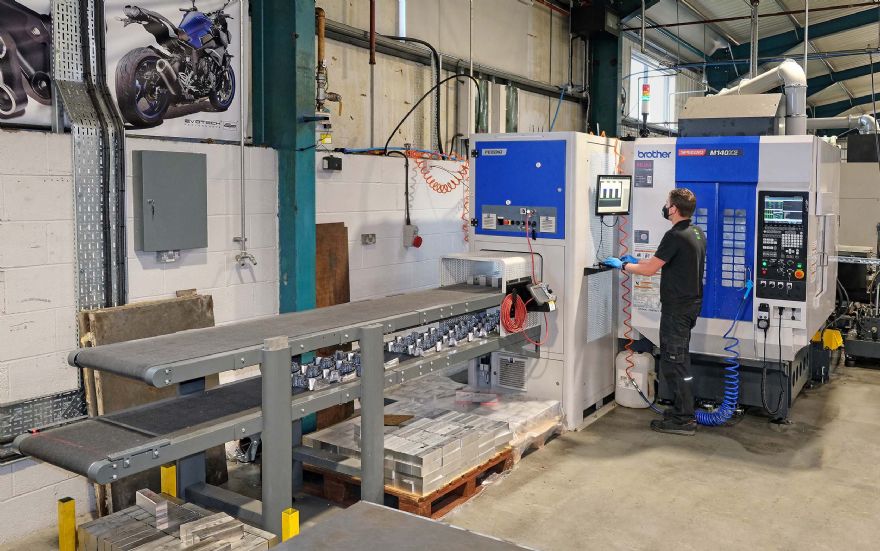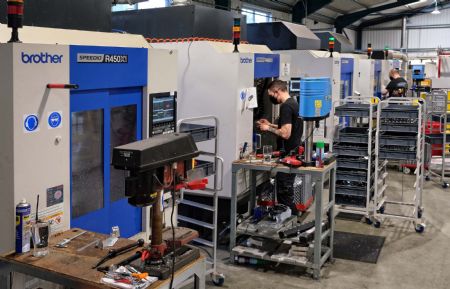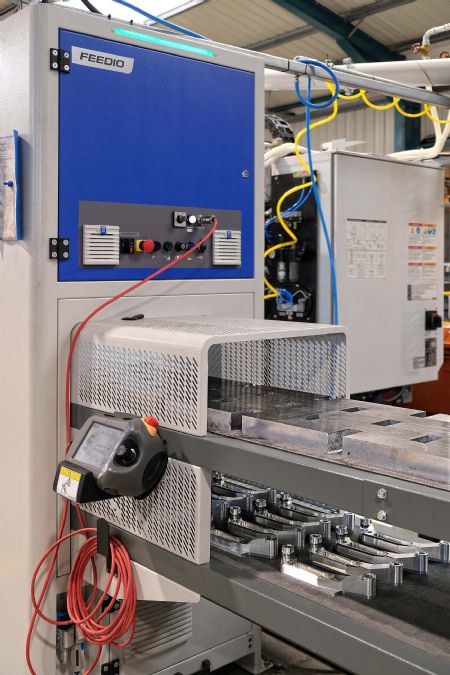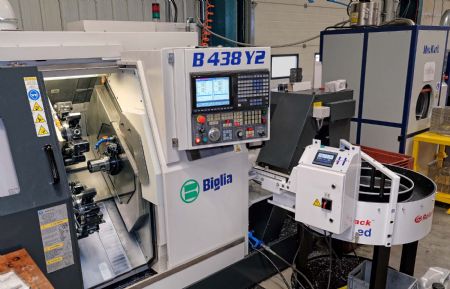 The first automated Brother cell, installed in March 2020, comprised a Speedio M140X2 five-axis mill-turn centre and a 2m-long Feedio, which shortly afterwards was extended to 4m
The first automated Brother cell, installed in March 2020, comprised a Speedio M140X2 five-axis mill-turn centre and a 2m-long Feedio, which shortly afterwards was extended to 4mDemonstrating that automated machining cells are the route to high production output in a small footprint with minimum operator attendance is Lincolnshire-based Drury Precision Engineering; and while the company undertakes a small amount of sub-contract machining, its main business is the production of its own ‘globally recognised’ motorcycle accessories for road and racing bikes. These are marketed under the Evotech Performance brand name.
Between March 2020 and February 2021, Drury installed three automated, Japanese-built Brother machining centres from sole UK and Ireland agent
Whitehouse Machine Tools Ltd, Kenilworth. Supplied with two of the machines were Brother’s Feedio vision-based robotic systems for component load/unload, while a System 3R WorkPartner pallet storage and handling system was integrated with the third machining centre.
For turn-milling, Drury had long been using a bar-fed single-turret lathe at its factory in Alford; this was recently replaced by a much more efficient Biglia B438-Y2 twin-spindle turn-mill centre with two Y-axis turrets; this machine was also supplied by Whitehouse Machine Tools. For producing motorcycle bobbin head bolts up to 200mm long from stainless-steel bar, Drury bought its first sliding-head bar-fed lathe (from a different source) in January 2019, as this machine can manufacture these parts to a much higher quality than can be bought in from external suppliers.
Optimising efficiencyIt was in early 2015 that Drury decided to ‘transition’ from conventional 40-taper machining centres to faster 30-taper models, and thereby raise production efficiency to meet rapidly increasing demand for its Evotech products, which are mainly produced by taking light cuts from rectangular aluminium billets.

The output of the first machine to be installed — a Brother Speedio R450X1 twin-pallet 22-tool 30-taper machine for three-axis work — equalled that of two 40-taper machining centres. For example, a typical crash protector took 20min to machine instead of 40min, thanks to a 16,000rev/min spindle and 200-block look-ahead in the Brother control — plus the shorter idle times resulting from faster linear moves and the particularly rapid tool change and pallet change taking place simultaneously.
The tool change offers a chip-to-chip time of typically 2sec, allowing Drury to introduce a couple of extra tools into a cycle — to add cosmetic features, for example — with very little time penalty.
Drury no longer has any 40-taper machines on site, as the R450X1 was followed by four further 30-taper Speedios.
An R650X1 arrived soon after the first Brother; this was equipped with a Nikken two-axis table to provide a five-axis machining capability. Next was a three-axis R450X2, a three-axis R650X1, which was followed — at the end of 2019 — by a five-axis S700X1 with a Nikken table. This machine was originally to have been reserved for prototyping but was quickly co-opted into production due to ever increasing demand for Evotech Performance products. All five machines are positioned in a line on the shopfloor and are manually operated.
Opting for automationIn early 2020, the three engineers who jointly run Drury — Dan Rack, Chris Vines and Nick Cooper— recognised that prismatic machining capacity needed to be increased further; but with space on the shopfloor limited, in March that year they bought the first of their automated cells — a five-axis Speedio M140X2 featuring a Feedio component storage and robotic handling system that was developed jointly by Brother and ABB specifically for Brother machines. The unit communicates with the machining centre control via a Profibus interface, while a ‘smart’ ABB teach pendant incorporating a customised Speedio page is provided for programming the six-axis robot.
As delivered, the Feedio supplied with this machine had a pair of standard 2m-long conveyors positioned one above the other, but Drury soon realised that these could not accommodate the output from the whole of a ‘ghost shift’ and asked Whitehouse to extend the conveyors to 4m — a ‘simple exercise’ that took less than a day. Moreover, when machining certain parts, up to three days of uninterrupted production can be obtained without manual intervention.
A camera and PC built into the Feedio unit allow the robot to detect where on the upper input conveyor billets have been placed. After machining, components are returned to the output conveyor below. This particular cell has been configured for Op 1 work on parts weighing up to 10kg in batches of from 100- to 2,000-off, with completion by Op 2 being carried out on the manually-loaded Speedios.
To ensure system reliability, the M140X2 (it has a work envelope of 200 x 440 x 305mm) has been equipped with two Blum probes, one to check the tool and the other to confirm correct loading of each billet before machining starts. Mr Cooper, who manages the machining department at Alford, says careful attention is paid at the component design stage to maximise Op 1 time and thereby minimise the amount of Op 2 metal cutting.

Nearly a year later the two other automated Speedio cells were installed. One was based on a three-axis S700X2 with a 700 x 400 x 300mm work envelope, a Schunk pneumatic centric vice and a 4m Feedio system capable of handling components weighing up to 2 kg; and again, this cell was for Op 1 work.
The other cell was also based on a five-axis M140X2, but this time fitted with a System 3R WorkPartner 108-pallet storage and handling system, the aim being to target Op 2 inefficiencies within the factory. Six motorbike parts required in left and right hand versions were identified as ideal for production in this cell; they are set up permanently so that both Op 1 and Op 2 are completed automatically and unattended for up to 20hr.
Furthermore, Mr Vines says the automated machining of aluminium requires a focus on the management of swarf, which increases to about 10-times the volume of the solid. When the first Speedio was installed, Whitehouse recommended the installation of a briquetting system for swarf compaction; this went on to serve the subsequently installed machining centres, while a second such compactor was added with the arrival of the Brother/System 3R cell.
Mr Cooper also highlights the fact that the M140X2s are equipped with a 2,000rev/min table that can undertake turning operations within a prismatic machining cycle; and while this facility has yet to be used for metal cutting, it has proved useful for ‘spinning’ components after machining to remove swarf, first with coolant to wash down and then without to dry the parts before extraction by the Feedio or WorkPartner.
Enhanced turning capabilityAs mentioned earlier, Drury had been using a lathe that was capable of turning components up to 65mm in diameter from bar, but this machine’s single turret meant that productivity was low — and it was inefficient at producing small turned parts. This situation prompted Drury to concentrate on in-house turn-milling of sub-38mm-diameter components and to sub-contract out the remainder of turned parts production. The company says it needs to retain some turning capability for the prototyping phase of new products and the completion of a first production run.
Mr Rack, who heads the turning section, said: “We knew we wanted a twin-turret machine to raise productivity by being able to carry out Op 1 at the main spindle and simultaneously complete Op 2 at the counter spindle.
“We considered two alternatives but decided in favour of the Biglia B438-Y2, which can have three tools in cut simultaneously, due to the high level of service we have received from Whitehouse on the prismatic machining side.”
Other points in favour of the Biglia were the ready availability of a post processor and the machine’s ability in its standard configuration to extract parts up to 150mm long without the need for special handling equipment, which would have introduced delay at the end of some cycles.

The machine — the most recent to be installed by Whitehouse at the Alford factory — has proved to be highly efficient at producing spacers for bar ends and crash protection brackets, for example, in a cycle time of around 1min compared with the the 3min previously needed.
Mr Rack also says that every turned and turn-milled part seems to be produced in around one-third of the time it took before on the single-turret lathe; he adds that Drury’s Edgecam programming system helps to balance operations at the main spindle and counter spindle, the aim being to carry out 60% of the cycle during Op 1 so that the counter spindle can complete the other 40% plus part extraction in a similar time.
While some components do not require any milling or drilling, around half of the lathe’s throughput involves some driven-tool work — although occasionally a part is produced without any turning at all, such as a component required for a satnav system. A lot of use is made of pinch turning and milling using both turrets at either spindle, as well as of deburring the reverse of components to avoid another operation.
Although turning in Drury’s factory has always been automated by a bar feeder, the inception of automatic loading and unloading of prismatic machining plant has seen a step-change in production efficiency.
Six years ago the company employed 22 staff, yet today with only three extra operators — and in the same shopfloor area — turnover has more than doubled. Indeed, Mr Vines likens the current factory environment to ‘The Elves and The Shoemaker’ fairy tales written by the Brothers Grimm: production continues throughout the night with no effort by Drury’s staff and the next morning there are a lot of finish-machined components ready to be powder coated, assembled or packaged for sale.